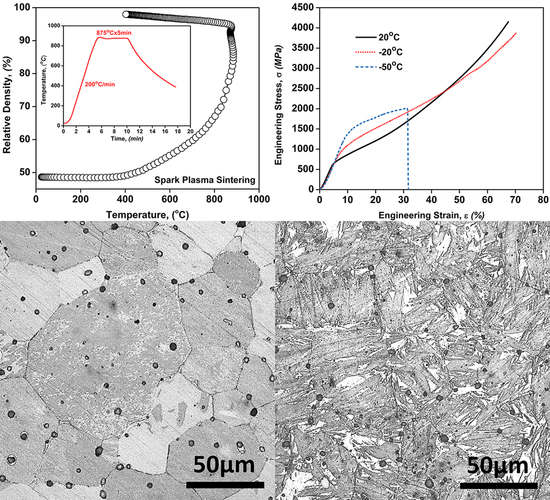Low-Temperature Induced Martensitic Transformation Enhancing Mechanical Properties of Metastable Fe-Ni-P Alloy
Abstract
:1. Introduction
2. Materials and Methods
2.1. Synthesis Process
2.2. Characterization
3. Results and Discussion
3.1. Microstructures of Metastable Fe-Ni-P Alloys after Cryogenic Treatment
3.2. Mechanical Properties of Metastable Fe-Ni-P Alloys after Cryogenic Treatment
4. Conclusions
Author Contributions
Funding
Conflicts of Interest
References
- Santos, A.P.R.; Mota, T.C.; Segundo, H.V.G.; Almeida, L.H.; Araújo, L.S.; Rocha, A.C. Texture, microstructure and anisotropic properties of IF-steels with different additions of titanium, niobium and phosphorus. J. Mater. Res. Technol. 2018, 7, 331–336. [Google Scholar] [CrossRef]
- Katiyar, A.K.; Rajput, S.K.; Mehta, Y. Microstructural Evolution of High Phosphorus Steel Using Warm Multiaxial Deformation. Mater. Today Proc. 2017, 4, 9380–9383. [Google Scholar] [CrossRef]
- Muthuchamy, A.; Kumar, R.; Annamalai, A.R.; Agrawal, D.K.; Upadhyaya, A. An investigation on effect of heating mode and temperature on sintering of Fe-P alloys. Mater. Charact. 2016, 114, 122–135. [Google Scholar] [CrossRef]
- Trivedi, S.; Mehta, Y.; Chandra, K.; Mishra, P.S. Effect of chromium on the mechanical properties of powder-processed Fe-0.45 wt.% P alloys. J. Mater. Process. Technol. 2010, 210, 85–90. [Google Scholar] [CrossRef]
- Chai, W.; German, R.M.; Olevsky, E.A.; Wei, X.; Jiang, R.; Cui, G. Preparation and Properties of High Strength Fe-Ni-P Ternary Alloys. Adv. Eng. Mater. 2016, 18, 1889–1896. [Google Scholar] [CrossRef]
- Grabke, H.J.; Moller, R.; Erhart, H.; Brenner, S.S. Effects of the Alloying Elements Ti, Nb, Mo and V on the Grain Boundary Segregation of P in Iron and Steels. Surf. Interface Anal. 1987, 10, 202–209. [Google Scholar] [CrossRef]
- Zhong, L.; Wu, R.; Freeman, A.J.; Olson, G.B. Effects of Mn additions on the P embrittlement of the Fe grain boundary. Phys. Rev. B 1997, 55, 11133. [Google Scholar] [CrossRef]
- Jiang, R.; Li, A.; Cui, G.; Zhang, C.; Chen, H.; Wang, Y. Influence of Ni-P content on microstructure and mechanical properties of Fe-x(Ni+P)-1Cu alloys. Mater. Sci. Eng. A 2017, 707, 1–11. [Google Scholar] [CrossRef]
- Song, S.H.; Zhuang, H.; Wu, J.; Weng, L.Q.; Yuan, Z.X.; Xi, T.H. Dependence of ductile-to-brittle transition temperature on phosphorus grain boundary segregation for a 2.25Cr1Mo steel. Mater. Sci. Eng. A 2008, 486, 433–438. [Google Scholar] [CrossRef]
- Kameda, J.; Nishiyama, Y. Combined effects of phosphorus segregation and partial intergranular fracture on the ductile-brittle transition temperature in structural alloy steels. Mater. Sci. Eng. A 2011, 528, 3705–3713. [Google Scholar] [CrossRef]
- Danilchenko, V.; Dzevin, I.; Sagaradze, V. Effect of Multiple Martensitic Transformations on Structure of Fe-Ni Alloys. J. Mater. Sci. Technol. 2013, 29, 279–282. [Google Scholar] [CrossRef]
- Chen, Z.; Chen, Q.; Liu, F.; Yang, X.Q.; Fan, Y.; Zhang, C.H.; Liu, A.M. The influence of solid-state grain growth mechanism on the microstructure evolution in undercooled Ni-10 at.% Fe alloy. J. Alloys Compd. 2015, 622, 1086–1092. [Google Scholar] [CrossRef]
- Swartzendruber, L.J.; Itkin, V.P.; Alcock, C.B. The Fe-Ni (iron-nickel) system. J. Phase Equilib. 1991, 12, 288–312. [Google Scholar] [CrossRef]
- Zhan, X.; Ernst, F. Crystallization micro-mechanism of near-eutectic amorphous Ni-P. Acta Mater. 2016, 104, 274–282. [Google Scholar] [CrossRef]
- Krishnan, K.H.; John, S.; Srinivasan, K.N.; Praveen, J.; Ganesan, M.; Kavimani, P.M. An overall aspect of electroless Ni-P depositions-A review article. Metall. Mater. Trans. A 2006, 37, 1917–1926. [Google Scholar] [CrossRef]
- Shongwe, M.B.; Diouf, S.; Durowoju, M.O.; Olubambi, P.A. Effect of sintering temperature on the microstructure and mechanical properties of Fe-30% Ni alloys produced by spark plasma sintering. J. Alloys Compd. 2015, 649, 824–832. [Google Scholar] [CrossRef]
- Shirazi, H.; Miyamoto, G.; Nedjad, S.H.; Chiba, T.; Ahmadabadi, M.N.; Furuhara, T. Microstructure evolution during austenite reversion in Fe-Ni martensitic alloys. Acta Mater. 2018, 144, 269–280. [Google Scholar] [CrossRef]
- Niessen, F.; Villa, M.; Somers, M.A.J. Martensite Formation from Reverted Austenite at Sub-zero Celsius Temperature. Metall. Mater. Trans. A 2018, 49, 5241–5245. [Google Scholar] [CrossRef] [Green Version]
- Chan, T.; Lin, S. Injection molding of Fe-Ni-P composite powders prepared by electroless nickel plating and the magnetic properties of the sintered alloys. J. Mater. Process. Technol. 1999, 89–90, 165–170. [Google Scholar] [CrossRef]
- Chan, T.Y.; Lin, S.T. Enhanced sintering of an Fe-Ni-P coated composite powder prepared by electroless nickel plating. JMEPEG 1997, 6, 628–632. [Google Scholar] [CrossRef]
- Bousnina, M.A.; Turki, F.; Schoenstein, F.; Tetard, F.; Rabu, P.; Smiri, L.S.; Jouini, N. Bulk nanostructured Ni-P alloys: Elaboration from metastable Ni-P nanoparticles by spark plasma sintering; mechanical and magnetic properties. J. Alloys Compd. 2016, 686, 252–266. [Google Scholar] [CrossRef]
- Jiang, R.; Li, A.; Cui, G.; Zhang, C. Comparison of Microstructure and Mechanical Properties of Sintered γ-(Fe-Ni-P) Alloys with Abundant P Doping. Metall. Mater. Trans. A 2019, 50, 2580–2584. [Google Scholar] [CrossRef]
- Guimaraes, J.R.C.; Rios, P.R. The mechanical-induced martensite transformation in Fe-Ni-C alloys. Acta Mater. 2015, 84, 436–442. [Google Scholar] [CrossRef]




| Temperature (°C) | Hardness (HV0.1) | Young’s Modulus (GPa) | Yield Strength (MPa) | Maximum Stress (MPa) | Maximum Strain (%) |
|---|---|---|---|---|---|
| 20 | 262 ± 21 | 15.5 | 608 | 4151 | 67 |
| −20 | 354 ± 32 | 15.8 | 716 | 3880 | 70 |
| −50 | 433 ± 27 | 17.5 | 1271 | 2010 | 31 |
© 2019 by the authors. Licensee MDPI, Basel, Switzerland. This article is an open access article distributed under the terms and conditions of the Creative Commons Attribution (CC BY) license (http://creativecommons.org/licenses/by/4.0/).
Share and Cite
Cui, G.; Jiang, R.; Zhang, C.; Liu, Y. Low-Temperature Induced Martensitic Transformation Enhancing Mechanical Properties of Metastable Fe-Ni-P Alloy. Metals 2019, 9, 785. https://doi.org/10.3390/met9070785
Cui G, Jiang R, Zhang C, Liu Y. Low-Temperature Induced Martensitic Transformation Enhancing Mechanical Properties of Metastable Fe-Ni-P Alloy. Metals. 2019; 9(7):785. https://doi.org/10.3390/met9070785
Chicago/Turabian StyleCui, Guodong, Runjian Jiang, Chengsong Zhang, and Yuxuan Liu. 2019. "Low-Temperature Induced Martensitic Transformation Enhancing Mechanical Properties of Metastable Fe-Ni-P Alloy" Metals 9, no. 7: 785. https://doi.org/10.3390/met9070785






